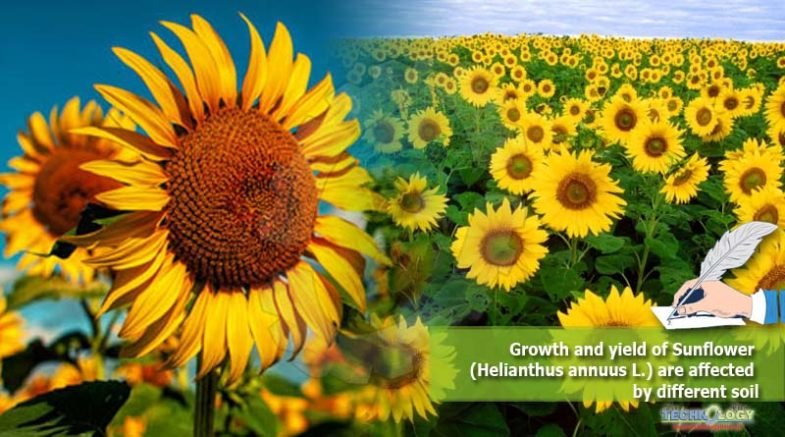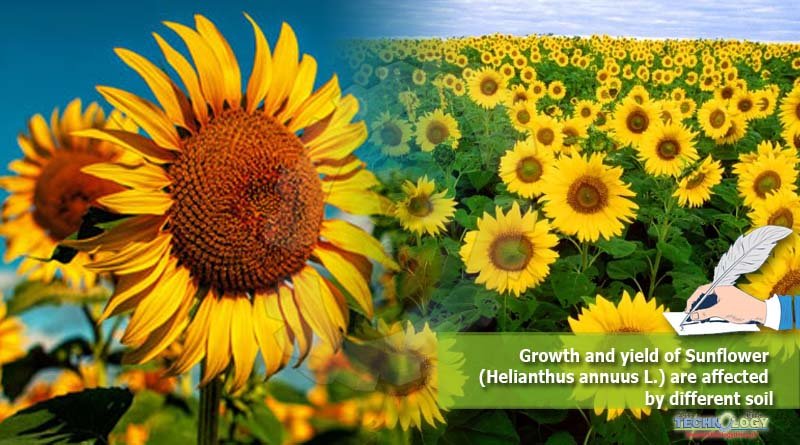Soil quality is an important factor that influences land use in agriculture and the sustainable development of agricultural systems. Pakistan is one of the countries that have been strongly affected by salinity and a large area of agricultural land is now unproductive due to salinity.
 A field study will be conduct to determine the effects of soil quality and depth on growth, seed yield and sunflower oil (Helianthus annuus L.) grown at increasing levels of soil salinity.
A field study will be conduct to determine the effects of soil quality and depth on growth, seed yield and sunflower oil (Helianthus annuus L.) grown at increasing levels of soil salinity.
A considerable reduction will be found in the growth parameters (plant height, stem diameter, number of leaves, leaf area index and disc diameter) in response to both depth and soil quality (salinity levels) . Also the yield in seeds and oil is reduced by salinity. Salinity reduces the micronutrient content (N, P and K) and absorption in sunflower leaves. The level of Mn, Zn and Fe will decrease, while that of Na and Cl will increase in the leaves and seeds of the plants. These changes in macronutrients and micronutrients in salinity conditions could result from the effect of salinity on nutrient availability, competitive absorption or division into leaves and seeds. Salinity and nutritional interactions reduced crop yield by an average of 20%, depending on the level of salinity and salt composition.
Introduction:
Agricultural land is an important component of the environment and the natural landscape. It includes the results of past and present human activities. Soil, as an important subsystem of land, which is changing over time as a result of changes in its environment or in its management. Soil quality is an important factor that influences land use in agriculture and the sustainable development of agricultural systems (Sepeh et al., 2002). Salinity is one of the biggest problems facing farmers around the world. More than 25% of the irrigated land is saline in Egypt, Iran, Iraq, India, Pakistan and Syria (Choukr-Allah, 1996). In some irrigated areas, salinization is exacerbated by the development of soil sodicity associated with the use of irrigation water that contains high concentrations of sodium, carbonate and bicarbonate (Barrett-Lennard, 2003 ).
Soil salinity limits crop productivity on irrigated land. Secondary salinity (that is, salinity induced by human activity) is a problem of desertification that increases global concern due to increased pressure on agricultural land for food production. Secondary salinity affects approximately 76.6 M has worldwide. This was mainly due to the increase in infiltration (due to irrigation or the elimination of deep-rooted vegetation), the development of shallow aquifers and the mobilization of salt stored in the soil profile on the soil surface. Pakistan is one of the countries that have been strongly affected by salinity and a large area of agricultural land is now considered non-productive due to salinity. In the Fayoum governorate, a large area of land becomes arid and inadequate for crop productivity due to soil salinization (Hans and Kevin, 2006). Sunflower represents one of the important oil crops in Pakistan (Mohamedin et al., 2004). There are very few reports of sunflower resistance to saline stress or alkaline stress (Liu and Baird, 2003). Sunflower contains a high percentage of polyunsaturated fatty acids and a low level of cholesterol. Sunflower cultivation in saline environments will lead to proper management practices that soil salinity threatens the permanence of irrigated land. This field study will then lead to determine the effects of soil quality and soil depth on growth, seed yield and sunflower oil grown at increasing levels of soil salinity.
REVIEW OF LITREATUR
Seed germination is a crucial phase of the plant’s life cycle. Which determines the success of the seedling plant and subsequent growth. At this stage, plants are more sensitive to environmental stress than other stages of growth and development. Numerous abiotic factors such as water, temperature, light and salts that regulate the germination of seeds interact in the soil interface. These factors can act as stress and cause injuries and even death of the plant in extreme cases (C.A. Jaleel et al., 2007). Among these, however, salt is the main factor that limits the germination of seeds and the establishment of plant seedlings that grow in the saline soil of arid and semi-arid regions (M. AL Mansour et al., 2010). In these regions, subsequent growth and final yield of cultivated plants decrease when the salt level is very high(C. Ghoulam and K. Fares., 2011)
Plant seeds often germinate better in non-saline conditions and their germination decreases with increasing salinity(M. A. Khan and I. A. Ungar., 2008). Saline stress can affect the germination of seeds by creating an external osmotic potential that prevents water absorption or due to the toxic effects of ions (M. K. Hosseini et all., 2013). Ionic effects can be distinguished from osmotic effects by comparing the effects of saline solutions and isotonic solutions of an inert osmotic medium such as polyethylene glycol (PEG) that cannot penetrate the cell wall. Germination inhibition in seeds treated with PEG is attributed to osmotic effects and any difference in germination of seeds treated with salt, compared to seeds treated with PEG, is attributed to ionic effects (G. L. Dodd et al., 2009). Some studies have shown that the inhibitory effect of sodium chloride (NaCl) on seed germination was more severe than that of isosmotic PEG, as in triple A prostate.
Sunflower belonging to the Asteraceae family is the fourth largest oilseed crop in the world (G. V. Zhao et all., 2011). And it is one of the most important economic crops in oilseed production in China. With the improvement of the standard of living, sunflower has become increasingly important in the production of vegetable oil, especially under conditions of controlled transgenic soy. Therefore, knowing the sunflower’s responses to saline stress facilitates its development in this area(J. L. Suo., 2010). There is much research on the responses of crops for sale, such as soybeans, rice and wheat but sunflower has little information on responses to salinity during seed germination. Temperature can interact with salinity to influence seed germination. Necessary germination inhibition, is detrimental to salinity and is generally reduced to an optimum germination temperature. Salinity-temperature interactions can have significant ecological implications in terms of germination time in field conditions.
MATERIALS AND METHODS
A field experiment will be conduct in University of Agriculture Faisalabad sub campus Burewala. The area is bound by canal irrigation and as well as tube well system, which facilitates the water dispose into drainage system. The experiment include four plots represents four different soil quality based on saline and alkali soil classification. There will be two different profile depths, i.e. 110, 100 and 80 cm. The experiment will be conduct during the summer season using sunflower (Helianthus annuus L.) Fedok varieties as imported cultivar. The experiment will be setup in a complete randomized design with two replicates for each treatment as follows:
- 100 cm soil depth in normal soil
- 100 cm soil depth in saline soil
- 100 cm soil depth in saline-alkali soil
- 100 cm soil depth in alkali soil
- 80 cm soil depth in normal soil
- 80 cm soil depth in saline soil
- 80 cm soil depth in saline-alkali soil
- 80 cm soil depth in alkali soil
The area of the plot will be 10.5 m² (5 ridges, each 3 m length and 0.7 m width) in health 20 cm apart. Farmyard manure, super phosphate (15.5% P2O5), and potassium sulphate (48 – 52% K2O) will be incorporated in to the soil during management practices at the rates of 20 m3, 30 kg and 24 kg/fed, respectively. Ammonium sulphate (20.5% N) at the rate of 60 kg/fed for the first season and 60 kg/fed for the second one, will be applied. Micronutrients will be spray thrice as chelates at the rate of 100, and 200 g/fed of Mn (EDTA, 13% Mn), Zn (EDTA, 14% Zn) and Fe, respectively. Representative plant samples of two replicates of each treatment were randomly taken after 90 day of sowing. The following measurements will be determined during the two successive seasons.
Sunflower vegetative growth
Plant height (cm) will be measure from the cotyledon node to the upper-most height of the plant. Stem diameter, leaf number and leaf area index (cm2) also measure.
Yield and its components
Seed yield (kg/fed), weight of 1000 seeds (g) will be determine. Seed oil % will estimate using sox-let apparatus and petroleum ether as a solvent.
Chemical analysis of leaf and seeds
Macronutrients (N, P and K) concentrations will be determine as g/100 dry weight and up-take as mg/plant. Micronutrients concentrations will be determine as mg/kg dry weight.
Statistical analysis
The results will be subject to analysis of variance. The combine data of both experimental seasons will be use for the presentation of results and the least significant difference (L. S. D.) at 0.05 level of probability also calculate. Regression analysis also used in order to examine the relation between soil EC and weight of 1000 seed.
REFERENCES
Abd el-kader ,A.A, A.A.M. Mohamedin and M.K.A. Ahmad.2006. Growth and Yield of Sunflower as Affected by Different Salt Affected Soils. Int. J of Agri. Biology.8.583-587
Ajmal., M. K and B. Gul.2008. High salt tolerance in germinating dimorphic seeds of Arthrocnemum indicum. International Journal of Plant Sciences. vol. 159(5).826–832
AL-Mansouri., M, J.-M. Kinet, and S. Lutts.2010. Effect of salt and osmotic stresses on germination in durum wheat. J of Plant and Soil. Vol:231.243–254
Choukr-Allah., R, C.V. Malcolm and A. Hamdi.1996. The potential of halophytes in the development and rehabilitation of arid and semi-arid zones. Halophytes and Bio-saline Agriculture.1.3–13
Dodd., G. L and L. A. Donovan.2009.Water potential and ionic effects on germination and seedling growth of two cold desert shrubs. The American Journal of Botany.86(8).1146–1153
Hans., C.J and W.J. Kevin.2006. Environmental Profile Fayoum Governorate. International Journal Of Agriculture & Biology .8.583-587
Jaleel., C.A, R Gopi, P. Manivannan, and R. Panneerselvam.2007. Antioxidative potentials as a protective mechanism in Catharanthus roseus plants under salinity stress. Turkish Journal of Botany.31.245–251
Liu., X. and W.V. Baird.2003. Differential expression of genes regulated in response to drought or salinity stress in sunflower. J. of Crop Sci.43.678–687
Mohamedin., A.A.M, A.S.A. Osman, N.M. Badr and K.I. Kotb.2004. Productivity of sunflower yield and yield composition under different drainage systems at Egyptian salt affected soils. Egypt J. Appl. Sci.19. 749–63
Qureshi., R.H and E.G. Barrett-Lennard.1998.Saline Agriculture for Irrigated Land in Pakistan. Australian Centre for International Agricultural Research. Handbook, P: 142
Sepeh., E, M.J. Malakouti and M.H. Rasouli.2002. Effect of K, Mg, S and Micronutrients on the Yield and Quality of Sunflower in Iran.17th WCSS.P: 2260.14–21
Suo., J. L.2010.Analysis of the effective chemical constituents in the disc of Helianthus annuus.(M.S. thesis).Xinjiang University China
Zhao., G.V, P. Zhong, X. Chen.2011.Recent progress and the development strategy of sunflower in China. Food Industry.10.76–78
